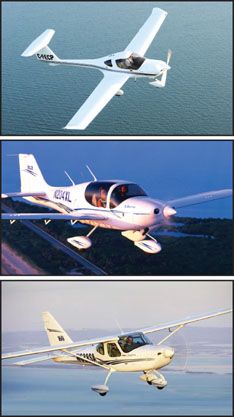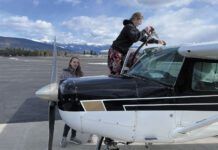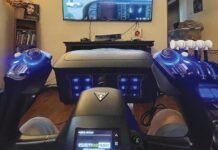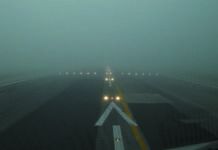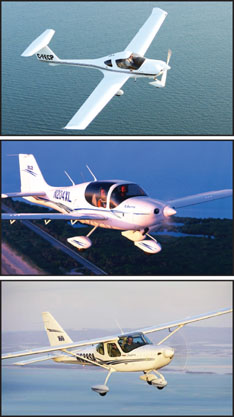
by Paul Bertorelli
Heres a number to ponder: A full decade after the first appearance of composite trainers in the U.S., the FAA has about 375 composite two-seaters on the registry. There are five times as many Cessna 150s still flying-and thats just one model year of the 150, 1966.
There are two ways to look at this dichotomy: Either the idea of new, two-seat trainers has flopped miserably or there’s soon to be a bottomless pit of demand as those old 150s and 152s finally wear out. At least two companies are banking on the bottomless pit theory or at least strong enough demand to support a two-seat line.
Both Symphony Aircraft Industries and Liberty Aerospace are seriously challenging Diamond in a two-place market that has proven anything but robust. Aside from the trainer market, both companies-and Diamond, too-see some sales in what can best be called the sport touring market. These are owners who want recreational airplanes suitable for short trips, but don’t need to haul a lot of stuff or go very far. Some are stepping down from more capable airplanes that they just don’t need anymore.
With this dual use in mind, we recently conducted a head-to-head comparison between the Diamond DA20 C1 Eclipse, the Liberty Aerospace XL2 and the Symphony 160. Here are our findings.
Origins
All three airplanes have evolved from European or UK design or manufacture.The Katana debuted in North America in 1994, having been developed in Austria by Diamond, which bought out the assets of HOAC Austria Flugzeuwerk and used its manufacturing and design base for the DV20 Katana. In 1992, Diamond set up manufacturing in London, Ontario where it still makes both the DA20-now called the Eclipse-and the four-place DA40 Star.
The original Rotax Katana variant, now known as the A1, was a lukewarm seller in the U.S., lacking both sufficient power and interest from Rotax in a follow-on engine. At airframe number 331, Diamond switched to Continentals 125-HP IO-240B, giving rise to the C1 Katana. The majority of A1s have been remarketed in Europe, where they are prized for their fuel efficiency.
Like the Eclipse, the Liberty XL2 also has the IO-240, but a new version known as the IOF-240, the F signifying an engine driven by Continentals PowerLink FADEC. The Liberty, a hybrid carbon fiber/metal design, was conceived by the same UK company that created the Europa Experimental, a unique airplane with a retractable single center wheel that eventually evolved into a tri-gear version loosely related to the XL2. But the XL2 is still a clean sheet design, according to Liberty. The XL2 has evolved incrementally since 1997 and is in full, certified production at the companys plant in Melbourne, Florida. Were told the XL2 is finding some flight school orders, although not many are flying yet.
The Symphony can be said to be an American design but a German company called OMF certified it and brought it into production. Through a sometimes rocky relationship, OMF essentially certified the Stoddard Hamilton Glasair kitplane, built a factory in Germany, but fell short on marketing and sales and sunk into bankruptcy. In 2004, a new group of investors bought OMFs assets, launched Symphony Aircraft Industries and is building the airplane-now called the Symphony 160-in Three Rivers, Quebec.
The Basics
Although the three airplanes have one thing in common-they are all entirely or partially composite-the designs are distinctly different. The DA20 C1 is all composite, retaining the original airplanes sleek, wasp-waisted glider looks with a large, rear opening bubble canopy that provides the best cockpit visibility of any of the three airplanes. Both the fuselage and wings are molded as a pair of halves which are bonded and cured. The Diamonds spar carry through is a beefy composite structure that also carries attach points for the steel landing gear legs. As with all three airplanes, the controls are conventional, but with sticks instead of yokes. Flaps and trim are entirely electric.
The competing airplanes can best be described as hybrid composites. The Symphony, as did the Glastar, has a fuselage of welded steel tubing not dissimilar to a ragwing airplane. But instead of fabric, the tubing is covered with molded composite panels screwed to the tubing, but the composites arent structural in any part of the airplane. The wings are conventional metal rib-and-skin riveted construction braced by a couple of a struts, just like a Cessna 150.
Although this construction is workmanlike, one downside of it is weight-the Symphony is the heaviest of the three airplanes-and a pair of downtubes obstruct the view out the windshield. While you get used to them, the DA20 isn’t so encumbered. And neither is the Liberty, which also uses steel tubing in its construction, but below rather than around where the occupants sit. As shown in the photo on page 9, the Liberty has a welded steel tube chassis that mounts the engine, landing gear, fuel tank, brakes and other key components. The fuselage section-which is made entirely of carbon fiber, not fiberglass-is mounted atop the chassis.
The Libertys carbon fiber construction makes it the lightest of the three, just a few pounds lighter than the DA20 C1 but nearly 500 pounds lighter than the Symphony. Nonetheless, the Symphony still has the highest useful load of the three.
Powerplants
Diamond hit the sweet spot with the Katana when it switched from the Rotax to the Continental IO-240, an engine with a good service history that can definitely be considered as the modern replacement for the venerable O-200 used in the Cessna 150. At 125 HP, the IO-240 has excellent fuel specifics for a small displacement engine and without a carburetor, carb ice isn’t a worry. Diamond says quite a number of IO-240s have reached their 2000-hour TBO, some several times over. We havent heard of any chronic service issues with this engine.
Stepping out to the edge of technology, Liberty is the only manufacturer to offer Continentals PowerLink FADEC in a certified airplane as standard equipment. PowerLink is an automotive-style electronic control system that uses pulsed fuel injection to automatically lean the engine based on throttle position and altitude, including ground leaning and lean-of-peak operation in cruise. Its a single-lever system with no mixture control.
While PowerLink does simplify engine operation by automating leaning, it also introduces another level of system management in that the new pilot has to become familiar with the PowerLinks health status panel in the cockpit.Rather than a conventional mag check, for instance, you flip a couple of switches to check the FADECs dual-channel redundant operation. Overall, we found both versions of the IO-240 in the Eclipse and Liberty to be easy to operate and both are surprisingly smooth for four bangers.
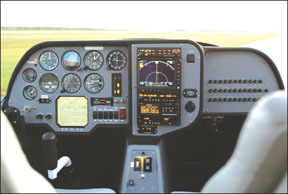
Thats less true of the Symphonys Lycoming O-320, the same 160-HP engine that has proven so reliable in the Cessna 172. Compared to the IO-240, the O-320 is noticeably more vibe prone, although we wouldnt call it objectionable. While it has more power, the Symphonys additional weight means it actually has higher power loading than the other two airplanes, so climb rate between the three is similar. Because its carbureted, the Symphony has carb heat and is thus susceptible to icing. We would prefer to see a fuel-injected engine, in keeping with the trend established by other manufacturers.
Panel, Ergonomics
None of these airplanes are easy to ingress or egress. We would rate the Diamond and Liberty as best in this regard. Using a step mounted in front of the wing, you can climb up into the Katanas cabin then flop back into the seats. Its hardly elegant, but its adequate. Exiting requires grabbing a hand hold on the glareshield and heaving yourself forward against the reclining angle of the seats. Its a struggle for those with bad backs, but its doable.
When we first test flew the Liberty, we complained about having no forward step, thus to ingress, you have to plant your butt on the wing, cheek walk toward the rear and slide your legs into the cabin. Liberty now offers an optional step, a considerable improvement. We wouldnt buy this airplane without the step.
Symphony has also added a step beneath the cabin door and although it helps, entering is still awkward, requiring a butt first approach into the door, then a swinging left or right leg lift over the center stick to get situated. To be fair, its not easy to enter a Cessna 150, either, but its worth mentioning that the industry hasnt made much progress in this regard.Given the size of these cabins, wishing for easy entry may simply be too much to ask.
Once youre settled into the seats, all three trainers offer substantially better ergonomics than do their 1960s progenitors. For seat comfort, we would rate the molded-back design in the Symphony as the best and these are the only seats to offer fore-and-aft sliding adjustment. The Katana and Liberty have only adjustable rudder position and in both of those airplanes, the seat pads sit atop immovable structural members so the seat angle is fixed; you have to adjust to it, not vice versa.
In our view, by far, Liberty has the most well-thought-out panel and cabin design, with the VM-1000 engine monitor mounted front and center and the avionics in a projecting center console.
Throttle and electric-only trim are on a center console between the pilots, with circuit breakers to the far right. Each seatback has a small storage cubby and you can reach back into the baggage compartment without undue contortion. The Libertys cabin is we’ll ventilated and-a plus-you can taxi with the gullwing doors wide open, which we did on a day with gusts to 27 knots.
This is one weakness of the Katana. With the canopy down and locked, which it must be for taxi, the cabin gets unbearably toasty on a hot day. You wont dally during the run-up. The payoff is cockpit visibility; nothing even comes close to the Katana in this regard. In flight, the cabin is we’ll ventilated and has a top shade panel that helps. Like the Liberty, engine controls are on a center pedestal, electric-only trim is on the sticks. We have no complaints about the Katanas panel design, although we think Libertys is a bit better.
The Symphony falls between the two. With conventional doors and posts, plus the downtubes, cockpit visibility is not nearly as good as in the other two and the wing is mounted far enough forward to require neck craning in the pattern. Skylights in the cabin roof let in light and help with upward visibility. For ground taxi, the cabin is kept comfortable by simply holding the doors open. The Symphony has conventional push-pull engine controls which, in our view, arent as comfortably situated as those in the Liberty and Katana. The Symphony is the only airplane of the three to have manual trim, which we prefer.
Performance, Handling
Following modern design trends, all three airplanes have castoring nosewheels and are steered by differential braking, meaning all will turn on a dime. The Libertys brakes are, well, quirky, being finger-operated levers -one for each brake-on the center console. These work fine but require some awkward fumbling with the right hand to work both the throttle and brakes at once.
Were not sure this design is a good idea in a trainer because no other airplane has it. Sure, you can adapt to them. But shouldnt a trainer prepare you for what you’ll encounter later? The Katana and Symphony have conventional toe brakes. We still find the Diamond brakes to be somewhat stiff, with very little travel in the pedal. But they hold we’ll and ground steering is adequate.
With similar power and wing loading, all three airplanes have similar climb rates-about 600 or 700 FPM initial, then holding 500 FPM to at least 4000 feet; more than adequate performance for a trainer, in our view.Although it has more power, the Symphonys additional power doesnt appear to give it a climb advantage, probably because of its higher weight.
With its slick airframe, the DA20 is also the fastest cruiser. At 4500 feet, we saw 132 knots in the Diamond, versus 125 knots in the Symphony and about the same in the Liberty. However, neither the Symphony nor the Liberty we flew were final production versions, so both may have a bit more cruise speed lurking in them. Even so, those speeds leave the Cessna 150/152 and even the 172 in their propwash on the same or less fuel.
All three airplanes are, as their manufacturers claim, fun and easy to fly. Control forces are light and relatively we’ll balanced and stall behavior is benign, especially in the Katana. Our only minor complaint concerns the Liberty. Compared to the other two, its lighter in pitch and we excited a pilot-induced oscillation on the first landing attempt. Ideally, we think a trainer should have slightly heavier control forces to avoid that problem.
Safety
All three manufacturers deserve credit for engineering trainers that are inherently safer than what went before them. Although we don’t like gullwing doors and canopies-Liberty and Diamond-and fuel or header tanks inside the cabin-all three-the manufacturers have taken steps to mitigate these risks.In all three airplanes, in-fuselage fuel storage is we’ll protected against crash forces.
Liberty has a stout carbon-fiber roll bar to protect occupants against a rollover and it provides a crash hammer for emergency egress. All three companies offer four-point harnesses, an improvement over lap and shoulder belts. Symphony is the only company to offer the BRS parachute system as an option in a trainer, which we applaud. It also has energy absorbing cans beneath the seat structure to cushion vertical loads in a crash.
But the DA20 C1 has something the other two lack: the proven best safety record of any airplane we have ever reviewed, bar none. Diamond estimates DA20 fleet hours at 2.1 million. With only four fatal accidents, that works out to under .2 fatal accidents per 100,000 hours and an overall accident rate of 1.3/100,000. Both those numbers are a fraction of the GA average of 1.31 fatal accidents per 100,000 hours and 6.8 overall accidents per 100,000 hours. The DA20s 34-knot stalling speed probably accounts for its low fatal accident rate. This will be a hard record to match, never mind exceed.
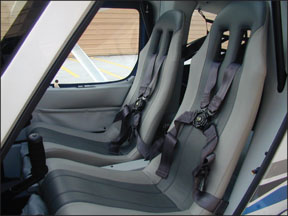
Wrap Up
So which is the top trainer? First, we’ll say this: None of the three is the wrong choice, in our view. Each is a more-than-capable classroom to teach someone to fly and all are superior to a Cessna 150/152, in our opinion. And each is suitable for the sport touring or inexpensive fly-about role that the manufacturers hope will eventually develop.
Our first choice remains the Diamond DA20 C1, Katana/Eclipse variant. Yes, it has some warts. The cockpit is tight and toasty in hot weather, it has limited payload and it isn’t IFR certified. But both the airplane and the company are proven quantities and the Katanas safety record appears unbeatable.
If IFR capability is a must or you need more baggage/payload, the Diamond is a non-starter and the choice reverts to either the Liberty or the Symphony. We lean toward the Symphony because it carries more, although the Liberty appears to have better range. We also think the glass panel and BRS options are pluses for the Symphony.
Either way, we think any potential buyer should examine both of these companies carefully with regard to potential long-term survival. Thus far, we like what we see-both Liberty and Symphony are reporting respectable sales to flight schools and in the end, their business plans may be proven correct.
Part of their success will be measured in how effectively each sweetens the sales deal against the competition and the fact that there is competition is good for both the companies and the buyers.
Also With This Article
“Price, Specs, and Checklists”
“Performance Points”
“Who Makes It, Who Doesnt?”

